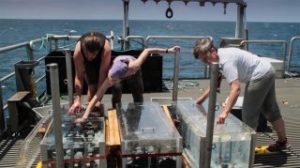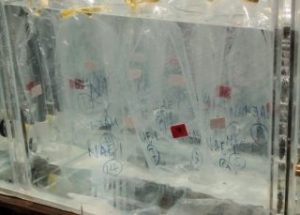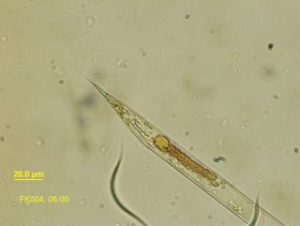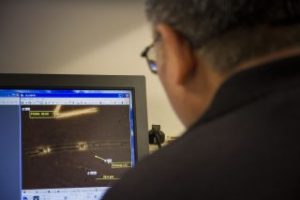14 June 2016
Unidentified Strange Object
Posted by larryohanlon
This is the latest in a series of dispatches from scientists and education officers aboard the Schmidt Ocean Institute’s R/V Falkor, currently on an expedition measuring nutrient fluxes to the South China Sea. Read more posts here, and track the Falkor’s progress here.
Dr. Lam Nguyen-Ngoc leans over his microscope. He is soon joined by fellow marine planktonist Hai Doan-Nhu, and they both smile. The news spreads fast and soon most of the scientific team pays a visit to their workstation in R/V Falkor’s dry lab. No matter how many times they have to load the images again, they are happy to oblige and share the excitement: the first of the organisms the experts are targeting in their research has made its debut.
Not only has Rhizosolenia turned out in the water samples collected in the latest CTD cast, but it has company: the cyanobacteria Richelia. The exciting aspect is they are together, coexisting in a intracellular symbiotic relationship. They are both a critical part of the natural system currently under study because they carry out key processes, such as Nitrogen fixation in the case of Richelia.
The next morning, the net tow comes onboard teeming with life. Now all of the organisms of interest are present.
The Thrill of the Unknown
The team knew that there was a strong possibility organisms would be found at some point. But then again, there is always a possibility of nets or samples coming up empty. The presence of such diatoms and bacteria is not the cause of enthusiasm, but the doors that these tiny beings open. There is still much to be learned about how they work, and now that the experts have carefully collected samples, they can dive in and start learning.
A new guest comes into focus. Hai calls for Maren Voss: has she seen this one before? Learning about expected organisms is cause for excitement, so deciphering what this creature is adds another level of intrigue. For the time being, Hai labels it “Unidentified Strange Object.” One more mystery to pack and bring back home.
Ask the Right Questions

Melvin, Sarah and Maren deposit water samples inside the incubators. Image credit: SOI/Monika Naranjo Gonzalez
If you want answers that only microscopic beings can give, experiments are the most direct path. The majority of the effort onboard goes into making sure that samples are adequately collected and preserved, but there is also opportunity for some analysis in the outdoor incubators.
Posing questions at a cellular level is complex. Scientists want to learn how these organisms work, as well as the kind of processes that they perform under various external factors. To search for answers, they will divide the water into several smaller samples and add nutrients in different concentrations. After a couple of days in carefully monitored conditions, researchers will return to the microscope and hope the images to start telling stories.

After a couple of days in controlled conditions, the samples in the incubators will start telling stories. Image credit: SOI/Monika Naranjo Gonzalez
Scientists understand that the answers they find will most likely lead to new questions. And that is what drives them, the endless seduction of detective work. For the time being, the microscope confirms that R/V Falkor is on the right path, sailing the waters where the Mekong and the ocean meet.
This post originally appeared on the Schmidt Ocean Institute blog.












 GeoSpace is a blog on Earth and space science, managed by AGU’s Public Information staff. The blog features posts by AGU writers and guest contributors on all sorts of relevant science topics, but with a focus on new research and geo and space sciences-related stories that are currently in the news.
GeoSpace is a blog on Earth and space science, managed by AGU’s Public Information staff. The blog features posts by AGU writers and guest contributors on all sorts of relevant science topics, but with a focus on new research and geo and space sciences-related stories that are currently in the news.